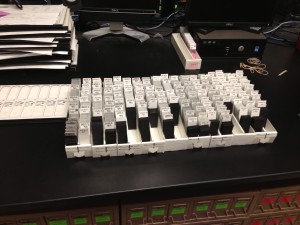An often overlooked and very necessary part of the lab is storing specimens. This was the job of the laboratory aides in the lab that I worked in. It takes a tremendous amount of time to make an efficient system for dealing with the flow of specimens we received while working at the lab at Caris Lifesciences.
The organization flow started when the specimen entered the company where it was given a case number. This number was used for all of the logging that occurred when the specimen passed through all the steps up to the case report. At any time, we could track where a case was based on the fastidious logging at each station. Because the life of someone is on the line, these logging steps prevent the mix up of tissue from one patient to the next. There are also a lot of auditing that goes on to make sure everything was where it should be. The laboratory information system (LIS) and sharepoint were some of the tools used for data logging and mining.

The lab aide spent most of their time moving slides around the laboratory. This distribution is key to efficient turn around time (TAT). We prided ourselves at Caris, that we could get a specimen in, and provide all the work required to make a good therapy regime, with a window of only 7 days or less. If all of the machines were operating and there were no holdups, this happened most of the time. Sometimes machines would go down or an antibody would not work properly, which would really slow the process down. At this point, the organization and distribution of the slides are key to making sure that everything gets done in the order it is suppose to.
